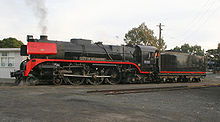Victorian Railways R class
A long overdue replacement for the 1907-era A2 class 4-6-0, their development and construction was repeatedly delayed due to financial constraints caused by the Great Depression and later the manpower and materials shortages of World War II and the immediate postwar period.
Once initial teething problems were overcome, R class locomotives proved to be a success and their power and speed enabled faster timetabled services.
Within a few years of the introduction of the A2 class 4-6-0 in 1907, it was clear that increasingly heavy train loads would require a more powerful locomotive on principal main lines.
The manually fired prewar VR S class Pacific, although capable of 2,300 drawbar horsepower (1,700 kW), was limited by the physical ability of the fireman to feed its 50-square-foot (4.6 m2) grate and as such was reliant on coal with a high calorific value.
The slotted pilot is Australian, the long sand dome American, the Belpaire firebox and cab British, and the mid-line smoke lifters ('elephant ears') European.
"[5] Other modern features included SKF roller bearings on all axles and the innovative, lightweight SCOA-P type driving wheels, which were specially developed for the R class by the Steel Company of Australia.
Australian Federal Government restrictions on the availability of US dollars, designed to favour trade within the British Empire, precluded the VR from purchasing American diesel-electric locomotives.
[13] Although of similar size to the X class 2-8-2 goods locomotive, the R's more modern design features such as larger volume smokebox and better valve events courtesy of larger 11-inch (280 mm) diameter piston valves with long 6-inch (150 mm) travel contributed to its significantly higher horsepower output than the 1,400 drawbar horsepower (1,044 kW) output of the X class.
[15] The Rs were pressed into secondary passenger and goods service, roles for which a Hudson with large diameter driving wheels was sometimes a less than ideal choice.
Furthermore, their relatively low factor of adhesion (4.08) and lack of fully compensated springing, coupled with the tendency of locomotives to transfer weight to the rearmost wheels under high drawbar pull conditions (which in the case of the R meant a weight transfer from the driving wheels to the unpowered trailing truck) caused them to slip when starting heavy goods trains.
In times of a good harvest, virtually every available locomotive would be marshalled into service to shift wheat trains of over 1,000 tons from Victoria's Western district through to the ports for export.
In the 1960s, as the railway preservation movement began to gather momentum, a small number of R class locomotives found a new role as power for excursion train services.
[17] R 707, which due to various defects had still not been put into service by 1954, was selected for modification for precipitated brown coal (PBC) operation in conjunction with trials of this fuel being undertaken with X class 'Mikado' X 32.
[18] While the PBC locomotives performed well, the expense of installing storage and handling facilities became increasingly uneconomic with falling prices for fuel oil and the success of diesel-electric traction.
The conversion had also reduced the water capacity of R 707's tender such that there was insufficient margin for delays or bad weather running on many routes, confining the locomotive to the shorter Melbourne to Geelong and Seymour lines.
A particular problem was the lack of feedwater treatment, which saw many R class locomotive boilers condemned for severe corrosion well before the end of their design life.
R 707 and R 761 continued to haul various special trains until both were withdrawn in 1974 as their boiler certificates expired, and with their withdrawal came the end of over a century of mainline steam locomotive operation on Victorian Railways.
[27] For a number of years, the modified R class locomotives could be seen in regular operation between Melbourne and Warrnambool, keeping a fast 3 hour 13 minute schedule which included six stops along the 267 km (166 mi) route.
[6] R 704 was painted in a one-off special livery of black with gold and red lining finished with stainless steel boiler banding for its display at the Festival.
Since restoration in the mid-1980s, both locomotives have hauled many special passenger trains for enthusiasts to various destinations on Victoria's remaining 5 ft 3 in (1,600 mm) network.
On 22 July 2012, R711 operated its first mainline tour open to the public, double heading with R761 to Traralgon as trailing engine, as part of the annual Snow Train.
The Smokebox end of the Locomotive was cosmetically restored for the Steamrail 2020 Open Weekend which included painting of running board, Tender and Steam Deflectors.










